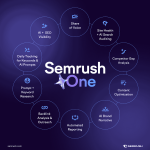In today’s hyper-competitive market landscape, content reigns supreme in dictating the success of digital marketing strategies. Expert copywriting isn’t just a tool; it is an essential component that brands leverage to communicate effectively, engage with their target audiences, and achieve business objectives. From enhancing brand awareness to driving behavioral changes among consumers, the words you choose and the messages you craft can significantly influence the effectiveness of your content strategy.
Copywriting serves as the strategic heartbeat of content marketing, blending creative writing with marketing acumen to produce material that not only captures attention but also encourages action. A skilled copywriter understands the nuances of language and the persuasive power of words, employing both to align with the brand’s voice and the expectations of the audience. By crafting narratives that resonate, copywriters turn ordinary messages into compelling communication vehicles.
The role of copywriting extends beyond crafting appealing content—it is also instrumental in shaping the digital presence of a brand through SEO. The integration of SEO practices with high-quality copywriting helps in pushing content to the forefront of search engine results, increasing visibility, and driving organic traffic. This symbiotic relationship between copywriting and SEO strategies ensures that content not only attracts but also retains the interest of its intended audience, turning casual browsers into loyal customers.
The Role of Research in Copywriting
Effective copywriting is rooted in thorough research. Understanding the market, the target audience, and prevailing competitive dynamics forms the cornerstone of impactful content. This depth of research helps in tailoring messages that are not only relevant but also deeply resonant with the audience’s expectations and needs. By aligning content with audience insights, copywriters can craft messages that are both persuasive and relatable.
In-depth knowledge of the audience’s demographics, preferences, and behaviors is crucial. This information guides the tone, style, and direction of the content. It’s not just about knowing who the audience is but understanding what motivates them, their challenges, and how your brand’s offerings can solve their issues. Such targeted content enhances engagement and fosters a stronger connection between the brand and its consumers.
For businesses looking to elevate their content strategy further, services like those offered by Designity provide a comprehensive suite of copy and content writing services. These services blend strategic insights with creative execution to deliver content that not only engages but also converts. By tapping into such agencies, companies can ensure their content is not only well-crafted but also perfectly aligned with their strategic objectives.
Strategic Content Development
Strategic content development lies at the intersection of creativity and business strategy. It involves identifying the right types of content that align with specific marketing goals and audience needs. This strategic alignment is crucial in determining not just what to write but how it should be presented to the audience to maximize engagement and conversion. Planning content types—be it blogs, white papers, or social media updates—is crucial in addressing different aspects of the consumer’s journey.
The diversity of content types allows a brand to engage with its audience at various touchpoints. For instance, educational blog posts can attract and inform new visitors, while in-depth white papers or case studies might convert those considering a purchase. Email marketing campaigns and regular newsletters help maintain ongoing relationships with existing customers, providing them with valuable updates and keeping them engaged with the brand.
Scheduling is another critical component of strategic content development. Consistency in content delivery helps establish brand reliability and can significantly enhance audience retention. It’s about creating a rhythm in your content release that matches the consumption patterns of your audience, ensuring that your brand remains fresh in their minds while also respecting their appetite for new information. This approach not only helps in building a loyal audience base but also in establishing a brand as a regular fixture in their digital experience.
Crafting Compelling Content Narratives
The art of storytelling is paramount in effective copywriting. Stories have the power to connect on an emotional level with the audience, making your message memorable and engaging. A compelling narrative can transform a simple piece of information into an impactful story that enhances the brand’s message and values. By weaving facts with emotive elements, copywriters can create content that audiences feel compelled to read and share.
Creating a narrative involves more than just relaying information; it requires the development of a storyline that aligns with the brand’s identity and the audience’s expectations. This narrative should have a clear beginning, middle, and end, each serving to attract the reader, provide valuable information, and encourage action, respectively. The use of metaphors, anecdotes, and vivid descriptions can add depth to the content, making it more engaging and relatable.
In addition to traditional storytelling techniques, modern copywriting often incorporates elements of user-generated content or real-life testimonials. This approach lends authenticity to the narrative, making it more trustworthy and relatable to the audience. By showing real-life applications of a product or service, brands can demonstrate their value in a concrete way, effectively using storytelling to bridge the gap between consumer needs and business offerings.
Leveraging Technology in Copywriting
In an era where digital technology shapes marketing landscapes, integrating technology with copywriting practices offers substantial advantages. Tools like content management systems (CMS) and customer relationship management (CRM) platforms streamline the content creation and distribution process, ensuring that content reaches the right segment of the audience at the right time. Moreover, these tools provide valuable data that can be used to refine and optimize content strategies over time.
Artificial intelligence (AI) and machine learning (ML) are also revolutionizing the field of copywriting. These technologies can analyze large volumes of data to identify trends and preferences, informing content strategies with unprecedented precision. AI-driven tools can help in generating initial content drafts, suggesting improvements, and even testing different versions of content to see which performs better with a particular audience segment.
However, while technology can augment the capabilities of a copywriter, it cannot replace the human touch. The intuition, creativity, and emotional intelligence of a skilled copywriter are irreplaceable. Technology should be seen as a tool to enhance these human skills, not as a substitute. By leveraging technology wisely, copywriters can free up more time for creative thinking and strategic planning, thus enhancing the overall quality and impact of their content.
Optimizing Content for Different Channels
Each content channel has its unique set of rules, audience expectations, and engagement tactics. What works on a blog might not resonate on social media, and vice versa. Understanding these nuances is critical for optimizing content across various platforms. Tailoring content to fit the specific context of each channel maximizes its effectiveness and ensures a cohesive brand message across the digital landscape.
For social media, content needs to be concise, engaging, and designed for sharing. Visual elements play a crucial role in catching the audience’s attention amidst the clutter. On the other hand, blog posts allow for deeper exploration of topics, providing detailed insights and comprehensive coverage. Each piece of content must be optimized not only for the platform it’s posted on but also for the devices it will be viewed on, considering the increasing consumption of content on mobile devices.
Email marketing requires a personal touch. Each message should feel tailored to the individual, addressing them directly and providing value in every communication. This personalized approach helps in building relationships with the audience, making them feel valued and understood. By meticulously crafting messages for different channels, brands can ensure that their content strategy delivers consistent results across all platforms.
Continuous Improvement and Adaptation in Copywriting
The digital landscape is ever-evolving, and so should content strategies. Continuous learning and adaptation are key to staying relevant and effective in the realm of content marketing. This involves regularly reviewing and revising content strategies based on performance analytics, audience feedback, and changing market conditions. A dynamic approach to content strategy keeps a brand agile and responsive, able to leverage new opportunities and overcome challenges as they arise.
Feedback loops are essential in this process. By monitoring how different pieces of content perform, brands can gain insights into what resonates with their audience and what doesn’t. This data-driven approach allows for fine-tuning of content strategies, ensuring that each piece of content not only meets the current needs of the audience but also anticipates future trends.
Moreover, ongoing education in emerging SEO practices, new social media platforms, and evolving consumer behaviors is crucial for copywriters and content managers. By staying informed about the latest developments and continuously honing their skills, professionals can maintain a competitive edge, ensuring that their content not only reaches its target audience but also engages them effectively.
Final Thoughts
Maximizing your content strategy through expert copywriting is about much more than just writing well—it’s about strategically crafting messages that resonate with audiences and achieve specific business objectives. From deep research and strategic development to the creative execution and continuous optimization, every aspect of copywriting is essential in shaping the effectiveness of your content. By leveraging the right skills and technologies, and continuously adapting to changes in the digital landscape, businesses can ensure that their content not only captures attention but also drives real results. In an age where content is everywhere, making yours count with expert copywriting is not just an option; it’s a necessity.
Lynn Martelli is an editor at Readability. She received her MFA in Creative Writing from Antioch University and has worked as an editor for over 10 years. Lynn has edited a wide variety of books, including fiction, non-fiction, memoirs, and more. In her free time, Lynn enjoys reading, writing, and spending time with her family and friends.















